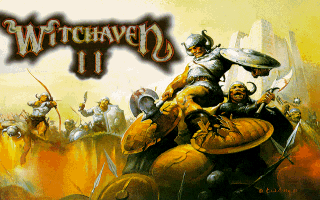Witchaven II
Jump to navigation
Jump to search
Witchaven II
There is no image of a modified version of this game — upload one!
| Levels? | |
|---|---|
| Tiles? | |
| Sprites? | |
| Fullscreen? | |
| Sound? | |
| Music? | |
| Text? | |
| Story/cutscenes? | |
| UI/menus? | |
| Demos? | Unknown |
The sequel to Witchaven, Witchaven II uses similar formats and data to its predecessor, but adds a few new features such as weapon enchantment shrines and the improved BUILD v7 map format.
Tools
Some of these may only work if a specific version is used.
The following tools are able to work with this game.
| Name | Platform | Archives | Levels | Graphics | Music | Sounds | Text | Saves | .exe patch | Notes |
|---|---|---|---|---|---|---|---|---|---|---|
| BUILD | DOS | No | Edit | No | No | No | No | No | No | |
| EDITART | DOS | No | No | Edit | No | No | No | No | No | |
| BastART | Windows GUI | No | No | Edit | No | No | No | No | No | |
| JOETOOLS | Windows | No | No | No | Edit | Edit | No | No | No |
File formats
The following file formats are used by this game.
| Filename | Format | Details |
|---|---|---|
| *.art | ART Format (Build) | Graphics |
| *.map | MAP Format (Build) | Game levels |
| JOESND | JOESND | Sound effect archive |
| F_SONGS | JOESND | Music archive (for Sound Blaster OPL) |
| W_SONGS | JOESND | Music archive (for any other music card) |
| capcd.smk | Smacker Video Format (SMK2) | Animated prompt to insert CD |
| intro.smk | Smacker Video Format (SMK2) | Intro video, normally resides on CD |
| stairs.smk | Smacker Video Format (SMK2) | Background for end-of-level score screen, normally resides on CD |
| ending*.smk | Smacker Video Format (SMK2) | Ending cutscenes (3 parts), normally reside on CD |
| hmiset.cfg | Plain text | Config, audio settings |
| pref.dat | PREF.DAT (Witchaven) | Config, settings that may be changed in-game |
| *.bnk | AdLib Instrument Bank Format (v0.0) | Instruments associated with HMP music |
! Fill in the rest of the files
Modding tips
- Unlike the first game, Witchaven II came with the BUILD map editor included on the CD.
- SMK files are usually played from the game CD. If the game is started with the LOCAL parameter, they will be played from the game directory instead and can thus be replaced in mods.
- The SMK files are version SMK2. Unfortunately, version SMK4 files (which are what RAD Tools makes) do not appear to work as replacements.
